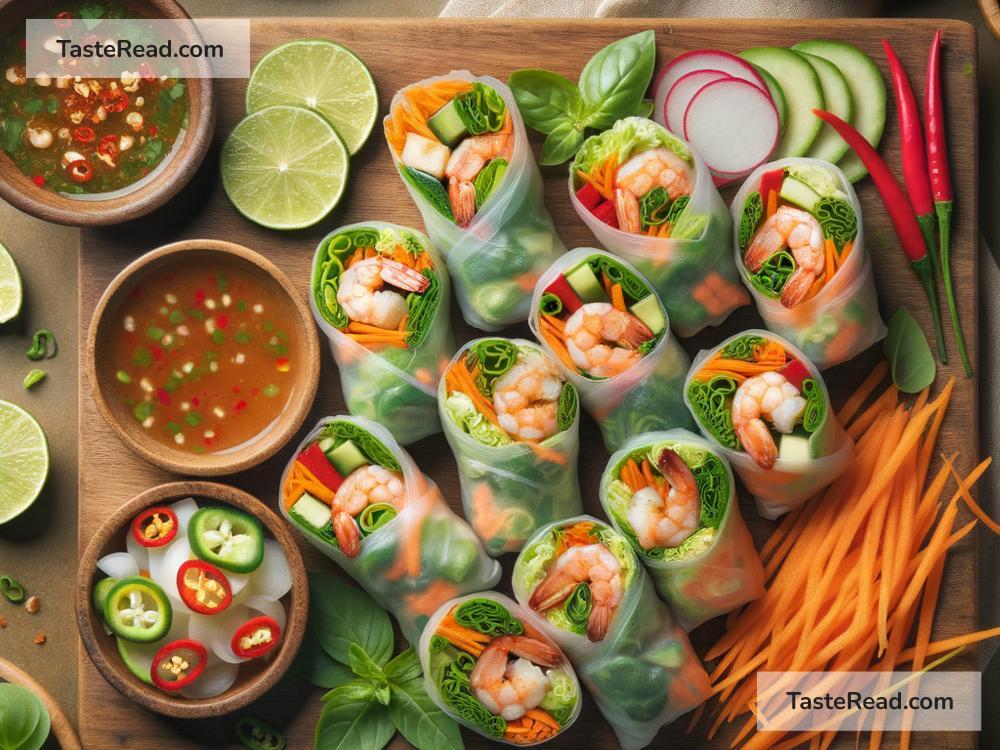How to Make Fresh Spring Rolls: A Simple and Delicious Recipe
Spring rolls are a popular dish around the world, especially in Asian cuisine. They’re light, refreshing, and usually served with a tasty dip. Fresh spring rolls are different from fried ones—they aren’t crispy but are made using soft rice paper wrappers filled with healthy ingredients like vegetables, herbs, and sometimes protein like shrimp or tofu. They’re easy to make at home, and you can customize the fillings to suit your taste. In this blog, I’ll walk you through how to make fresh spring rolls step by step, even if it’s your first time trying this recipe.
What You’ll Need
Before we start, here are the ingredients and supplies you’ll need:
Ingredients:
- Rice paper wrappers (these are thin and round, sold in most grocery stores or Asian markets).
- Protein: Shrimp, tofu, chicken, or even cooked egg slices.
- Vegetables:
- Thinly sliced carrots
- Cucumbers (seeded and julienned)
- Lettuce leaves or spinach
- Red cabbage (optional for extra color)
- Fresh herbs: Mint leaves, cilantro, and Thai basil.
- Rice noodles: Vermicelli noodles, cooked and cooled.
- Dipping sauce: You can use store-bought peanut sauce, hoisin sauce, or make your own.
Supplies:
- A large plate or shallow bowl for soaking the rice paper.
- A clean work area or cutting board.
- A sharp knife.
Step 1: Prep Your Fillings
Start by preparing all the ingredients. Wash the vegetables and herbs thoroughly, and chop them into thin, even pieces. Slice the protein into bite-sized strips. Cook and drain the rice noodles according to the package instructions—let them cool completely before adding them to the rolls.
Having everything ready and organized makes the rolling process much easier. Arrange the fillings in separate bowls or piles so you can easily grab each ingredient as you assemble the spring rolls.
Step 2: Soften the Rice Paper Wrappers
Rice paper wrappers are stiff when you first take them out of the package, but they soften quickly in water. Fill your plate or shallow bowl with warm water. Take one rice paper wrapper and dip it into the water. Submerge it fully for about 10–15 seconds, or until it becomes soft and elastic. Be careful not to soak it too long or it might tear.
Carefully lay the softened rice paper flat on your work surface or cutting board.
Step 3: Assemble Your Spring Rolls
Now comes the fun part! Place your fillings onto the lower third of the rice paper. Here’s a typical order to layer your ingredients:
1. Start with a layer of protein (shrimp, tofu, etc.).
2. Add a small handful of cooked rice noodles.
3. Add your vegetables (carrots, cucumbers, cabbage, etc.).
4. Top with fresh herbs like mint or cilantro.
Don’t overload the wrapper—keep it light so you can roll it easily.
Step 4: Roll the Spring Roll
To roll the spring roll, follow these steps:
– Start by folding the bottom of the rice paper up and over the filling.
– Then, fold the sides inward to seal the edges.
– Finally, roll the wrapper tightly from the bottom to the top.
Take your time and don’t worry if it’s not perfect—it gets easier with practice! Place the finished roll seam-side down on a plate so it doesn’t come apart.
Repeat Steps 2–4 for each spring roll until you’ve used up all your fillings. If the wrappers feel a little sticky, wet your hands lightly to help handle them.
Step 5: Make or Prepare Your Dipping Sauce
The dipping sauce is the star of the dish—it adds flavor and makes the rolls even more exciting. If you’re using store-bought peanut sauce or hoisin sauce, you’re good to go. But if you want to make your own, here’s a simple recipe for peanut dipping sauce:
Ingredients:
- 3 tablespoons peanut butter
- 2 tablespoons soy sauce
- 1 tablespoon hoisin sauce
- 1 tablespoon lime juice
- 1 teaspoon sesame oil
- A splash of water to thin the sauce (adjust as needed)
Instructions:
Mix all the ingredients together in a small bowl until smooth. Taste and adjust according to your preference. Add a pinch of sugar if you want it sweeter or more water if it’s too thick.
Step 6: Serve and Enjoy
Arrange the spring rolls on a serving plate. Serve them fresh with the dipping sauce on the side. They’re best eaten immediately while the rice paper is soft and the fillings are crisp. If you’re making them ahead of time, cover them with a damp paper towel to keep them moist.
Tips for Success
- Don’t overfill the wrappers. Too many ingredients can tear the rice paper.
- Practice makes perfect. Rolling spring rolls takes a little time to master, but it’s well worth the effort.
- Get creative. Feel free to experiment with different fillings like avocado, bell peppers, or shredded chicken.
Making fresh spring rolls is a simple and fun way to enjoy a healthy and flavorful meal. Once you’ve tried them, you’ll find endless ways to customize the recipe. Whether you’re hosting a party or just making dinner, fresh spring rolls are always a crowd-pleaser. So grab some rice paper and your favorite fillings, and give this recipe a try!


